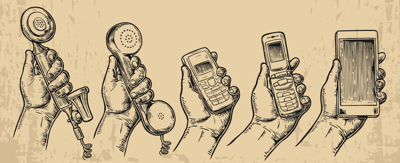

There was a time when communication was simple.
You either spoke with someone face to face or trusted that a note tied to a pigeon would eventually make it to the right person. With time, however, communication advanced in a lot of different directions, eventually making it almost effortless to send and receive messages.
Some would think that modern communication is simpler than the old-fashioned methods. It’s fast, easy and convenient. Simple, right? Nope! The opposite is actually true. With countless approaches to sending and receiving information, communicating is now a lot more complex.
If you want to learn more about a specific type of communication, jump ahead:
And if communication has become more complicated in general, imagine what has happened to business communication. When we take an extra minute to think about a message we are about to send, we start to wonder:
What type of communication should I be using?
How do I know which channel to use?
Is this subject appropriate to discuss using this method?
The proper use of the types of communication is crucial to the way people receive our messages. And while the number of communication channels can continue to grow, the types of communication will stay the same. This makes understanding the types of communication the first step to being the best communicator possible. In business, this workplace soft skill can make or break your success.
There are four types of communication that each include multiple channels.
But before we go on, let’s make one thing clear: there is a difference between types of communication and communication channels.
A communication channel is the actual tool we use to send information. The type of communication is the category that the channel falls under. For example, say you send an instant message. The type of communication is written communication because you wrote the message. The communication channel is the instant messaging software you used to send the message.
| TIP: Take these communication types a step further by applying them to communication theory. |
Alright, let’s get after it. Here are the types of communication and some channels that they include.
There is power in spoken words. A simple “yes” can open a door to a new opportunity and a harsh “no” can slam it in your face. Either way, the message is sent using verbal communication.
Verbal communication refers to the use of speech to send a message. We banter, gossip and tell jokes with friends, but there are also times we need to get serious about verbal communication. For example, in the workplace.
No matter the field you work in, verbal communication skills are necessary in business. Chefs holler when an order is up, ranch hands yell to corral livestock, and salespeople turn on the language charm to intrigue clients.
Like most types of communication, verbal communication includes a variety of channels to use.
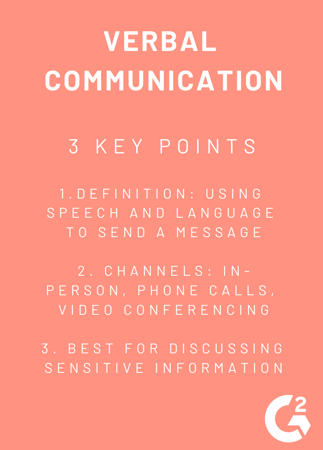
In-person communication is perfect for adding a personal touch to a conversation. You can email a remote coworker as much as you want, but nothing beats that first face-to-face impression to help you understand what kind of person, and worker, they really are. Most importantly, sensitive topics should exclusively be discussed face to face. Using an impersonal type of communication to tell someone important news, good or bad, undermines the seriousness of the situation.
Verbal communication also includes speaking over the phone. While not as personal as meeting in person, phone conversations allow people who are not physically in the same place to have a quick conversation. The topics can resemble a formal meeting or ones that are discussed when you stop by someone’s desk for a quick question or clarification.
And finally, video call is thrown into the mix. A great way to still add the pleasure of seeing someone’s face, but not needing to be in the same place if it is a hassle.
Consider the information you are about to discuss. If it is sensitive, verbal communication is your best bet. It may be difficult at times, but it is the most respectful way to share information.
If you have ever interacted with a baby who still can’t speak, you have had to make some guesses about what they are thinking, what they want, and whether or not they are happy through their actions. Successful or not, you are picking up on nonverbal communication cues to understand them.
Nonverbal communication is the way we communicate without using words. And while your posture, hands, and eyes can’t speak, they are saying more than you think.
In business, our nonverbal communication speaks volumes. We are expected to act and appear a certain way in the workplace to be considered professional. People around us pick up on the way we carry ourselves and translate those suggestions into levels of energy, interest, and respect.
The only channel we have for nonverbal communication is our body, but there are multiple carriers within it.
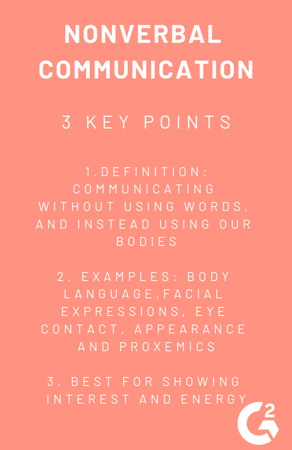
Body language, facial expressions, and eye contact are the loudest of nonverbal communication tactics. Leaning back in a chair with an expressionless face comes across as disinterested and unfocused. On the other more lively hand, sitting up straight and looking curiously into the speaker’s eyes conveys that you are intrigued and understanding the information being presented to you, even if that’s not really the case.
Parts of nonverbal communication that are often forgotten are our appearance and proxemics. The way we dress, keep our hair, and stay generally clean speaks to how much we value the situation we are in, people we are with, and place we are located.
Proxemics refers to the distance between the speaker and the speaker’s audience.. It may seem unimportant, but imagine a situation where the person you were speaking with stood so far away that you had to raise your voice. Or so close that you had to take a step back to avoid their bad breath. Stand close enough so the conversation is still personal, but not too close that the other person feels uncomfortable.
Check yourself. The nonverbal messages you are sending can easily be trumped by what you’re doing, or not doing.
“Write this down.” A good clue that significant information is coming your way. Thankfully, written communication provides us the tools we need to take note of it all.
Written communication is using the written word to convey information. The best attribute of written communication is that it can send large amounts of information without the risk of someone forgetting because it can be referred back to for reminders.
In business, this is especially important. Take a second to think about the number of messages circulating in a business.
What time is the meeting?
What do I need to include in that report?
What is included in the new benefits package?
It’s a lot. And the more these questions and answers are thrown around, the easier it is to forget important information. This is why businesses rely heavily on written communication. There are plenty of channel options to choose from, and situations that call for each one.
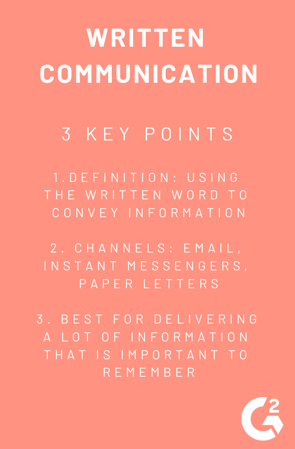
Email has taken over the business world. The convenience, handy features, and access from anywhere with Internet make it hard to beat. Email has wide ranges of formality and message length, giving it endless uses. However, it is easy to get caught up in the convenience of email. Some conversations are hard to have face to face, and it is tempting to avoid that by using email to discuss the touchy subjects. Recognize which topics are email appropriate, but more importantly, ones that aren’t.
Instant messaging is another tool that has contributed to the way people within a business communicate with each other. Typically used for internal communications, instant messaging is perfect for a quick, casual conversation that gets right to the point.
Technology is wonderful, but don’t forget about written messages on paper! Yes, as old fashioned as it may be, there are still plenty of uses for this type of written communication.
When delivering a large amount of important information, it might be best to go with a written communication channel. But be careful. Not all topics are appropriate for written communication.
Imagine someone describing a sunset with words only. Not very thrilling, right? However, once an image is added, you begin to grasp the true beauty of it. The words spoken about the sunset can help you imagine it, but visual communication is what helps you understand it.
Visual communication refers to messages that can be seen.
In business, visual communication can be characterized as a helper. Whenever a heavy amount of information is presented, a visual aid can help the message receiver comprehend the message.
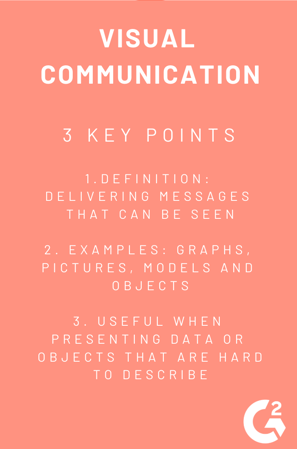
Graphs are a common and useful visual aid. A lot of talk and writing around the office can be packed with data about the business. Revenue and growth, debt and decline. Good to know, but hard to listen to. No matter how important it is, listing data can cause information to go in one ear of the audience and right out the other. A graph helps them turn those numbers into something more meaningful.
Other forms of visual communication, like photographs, models and physical objects can come in handy when you are struggling to find the right words to describe something. A photograph can help complete a message that is hard to describe with words. A model gives an example of an ideal final product for someone producing it for the first time. An object can help people better understand how something works, so they can relay that information to others.
Take a look at the information you are delivering. If it is loaded with numbers or phrases that could use some help from a visual aid, be sure to include one. Your audience will appreciate it.
As we sit in the midst of the Information Age, knowledge has never been more powerful. And as technology continues to muster up new innovations, there have never been more ways to communicate it. When sending a message, consider your audience and the information at hand. Bring both of those together to find the right type of communication and the appropriate channel.
Not so worried about internal communications and want more about the external side? Check out our resource on integrated marketing communications.
Mary Clare Novak is a Content Marketing Specialist at G2 based in Burlington, Vermont, where she is currently exploring topics related to sales and customer relationship management. In her free time, you can find her doing a crossword puzzle, listening to cover bands, or eating fish tacos. (she/her/hers)
It’s not what you said. Or even how you said it. It was your actions.
 by Mary Clare Novak
by Mary Clare Novak
Everything has a history.
 by Mary Clare Novak
by Mary Clare Novak
It is easy to use the wrong method to share important business information.
 by Mary Clare Novak
by Mary Clare Novak
It’s not what you said. Or even how you said it. It was your actions.
 by Mary Clare Novak
by Mary Clare Novak
Everything has a history.
 by Mary Clare Novak
by Mary Clare Novak
Never miss a post.
Subscribe to keep your fingers on the tech pulse.

